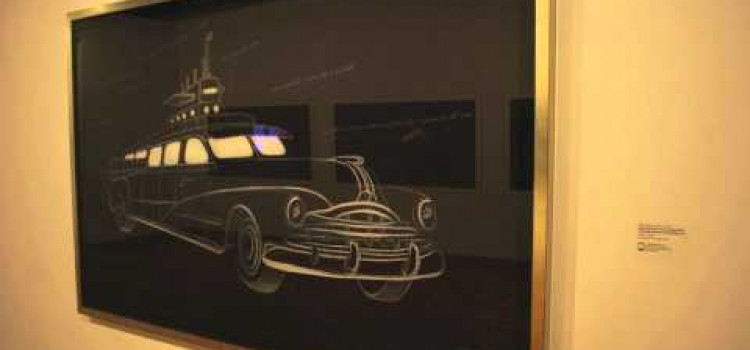

By Jesus Ambrosio & Michael Lozano
Just weeks before President Obama announced a change in diplomatic relations with Cuba in December, Cuban artist Esterio Segura was having his first solo exhibit in the United States.
It was opening night, Nov. 22, and Segura was at the Museum of Latin American Art (MOLAA) in Long Beach, Calif.
That night, visitors of the museum were allowed to leave a mark on the black and silver submarines of Segura’s “Submarino De Mi Pueblo” exhibit. They signed their names with silver sharpies to fill in the empty submarines on black canvas. The pieces will now be a permanent part of Segura’s art.
“In Cuba there is a law, a constitutional law that if you can get more than 2,000 signatures you can make your own political party,” Segura explained. “I just want to show that things can be changed when people can get together.”
Segura’s art has been part of private collections across California numerous collections around the world for years. The artist, whose pieces deal with migration and commonly challenge Cuban hegemony, has never had a solo exhibition in the United States until now.
“This show doesn’t have a title; the title is my name,” Segura said. “And it’s not because I want people to know my name, it’s because all the work that is here is myself. It’s who I am.”
Now that U.S. relations with Cuba are being restored, Americans may get a change to know who other Cubans are, too.
Since the 1990s, the Cuban government has allowed certain artists to travel to other countries. With Obama’s move to thaw Cuban relations, experts predict an influx of more Cuban artists may soon hit the United States.
“It used to be that only a smaller percentage of (Cuban) artists can come and go and market their work in the United States. Now, it’s going to get bigger,” said Stuart Ashman, CEO of the museum, who is also Cuban.
The easing of travel restrictions will likely mean an expansion of the Cuban art market, as more Americans can visit Cuba and buy art, thereby giving Cubans a new way to making a living.
“Everybody on the block (may) start slapping paint on canvass. Some of those are people who should have been artists and some who should not,” Ashman said. “The market will help filter it out.”
Cuban art at MOLAA is nothing new. Ashman has featured the works of other
Cuban artists such as Roberto Fabelo and Wifredo Lam at his museum, with an exhibit by a Cuban photographer coming later this year.
It may seem like an unlikely cultural hub for Cubans. Although about 42 percent of the population of Long Beach is Latino, there are only about 1,300 Cubans in the city, according to the 2013 American Community Survey,. But all Latinos can still find a bond with the themes expressed by Cuban artists, said Ashman.
“For example, in the work of Esterio Segura, he deals a lot with migration, moving from one place to another, which happens in almost every country in Latin America,” Ashman said.
For Segura’s exhibit, postcards with a picture of a suitcase were passed out. They read, “You’re leaving your country and the only things you can take must fit in this suitcase. What would you take?”
“That question touched home for me,” Ashman said. He was only 12 when he and his parents left Cuba in 1960 and were allowed to only take five suitcases.
“There was a lot of discussion of what to take. The most important was the family pictures,” he said. “Those are issues that people can really relate to.”
For years, the travel ban stifled meaningful exchanges between the two nations’ art scenes, Ashman said. “You had to go to exhibits in Europe or other parts of Latin America to see little crumbs of Cuban art here and there.”
Though travel restrictions to Cuba have been eased, there is still an embargo in effect, something the U.S. Congress must override in order to eradicate. The embargo caused the price of art supplies to skyrocket in Cuba. “Imagine what a tube of paint costs if you have to ship it in from Europe rather than from 90 miles away,” he said.
Ashman predicts that Americans coming to Cuba will find that Cuban art breaks stereotypes of what they had expected. “Artists are critics of society at times,” said Ashman, “and that’s not restrained the way you would think in Cuba.”

